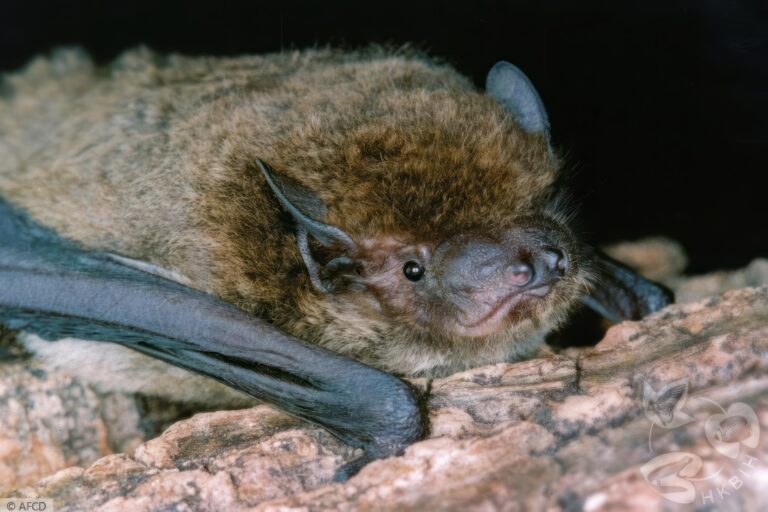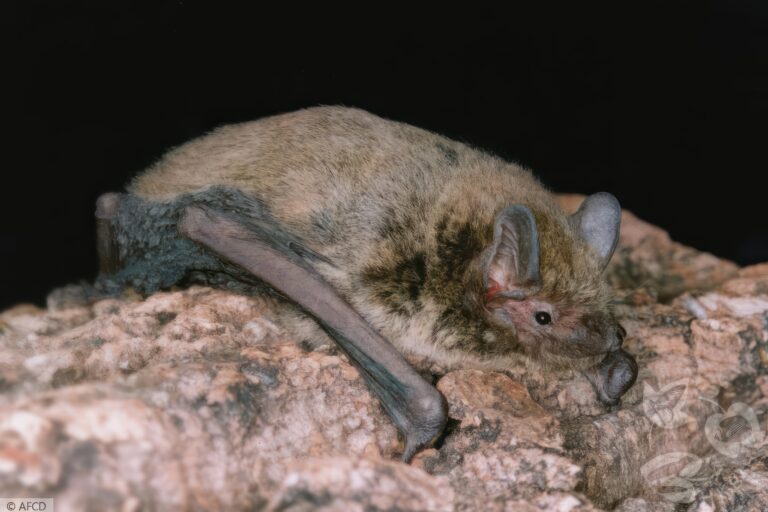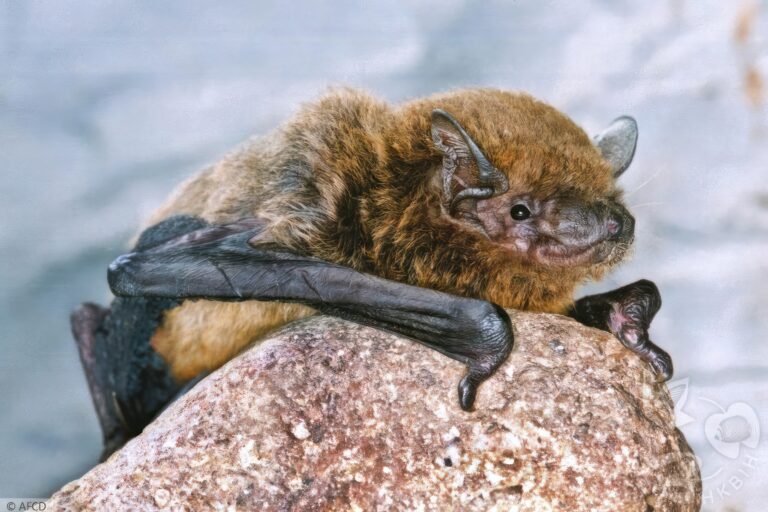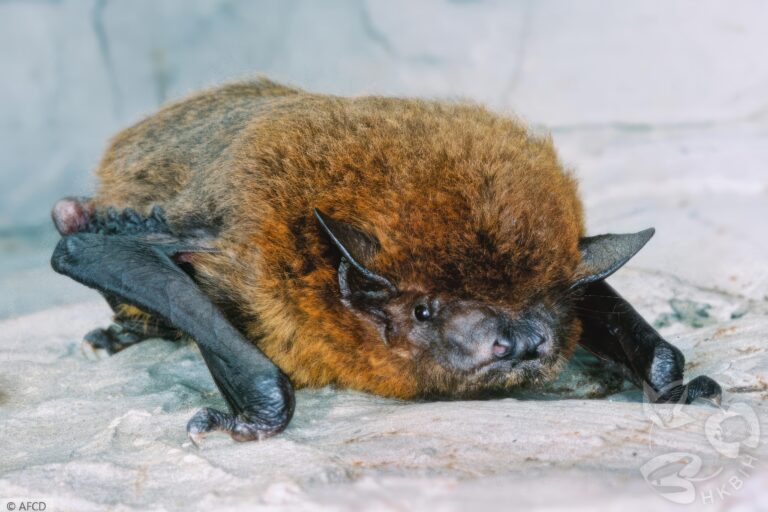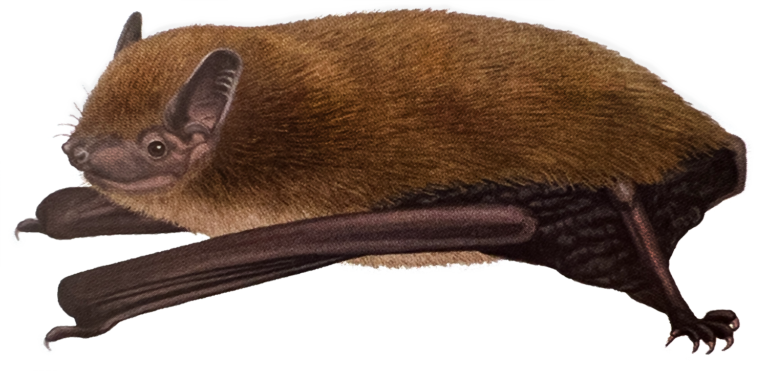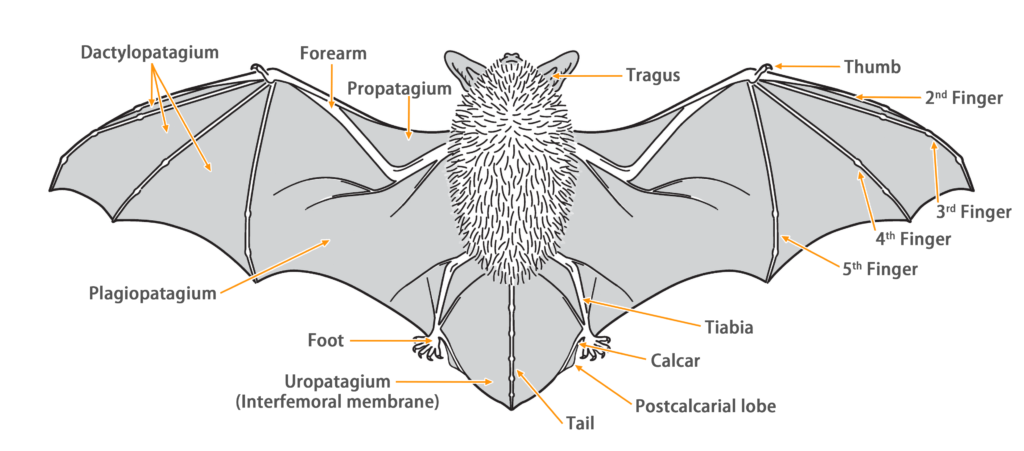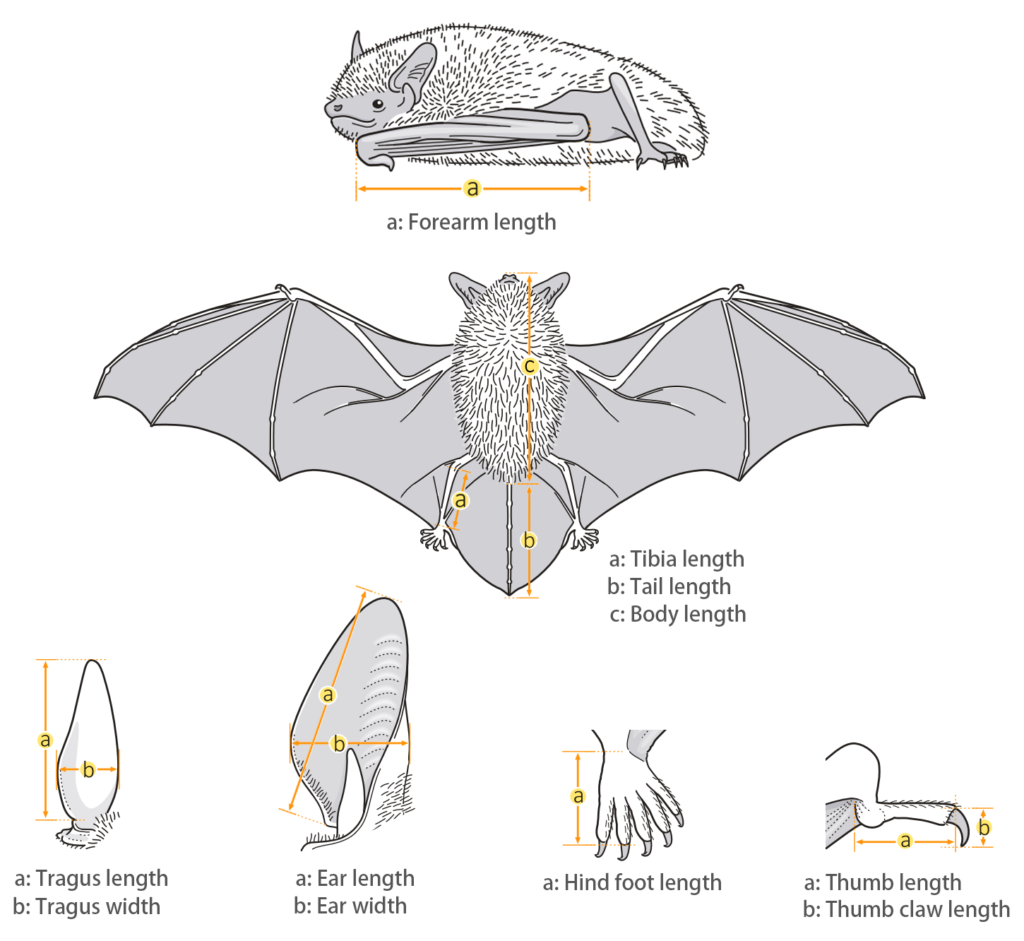- Hong Kong Bat Radar
- Kelaart’s Pipistrelle (Pipistrellus ceylonicus)
Kelaart's Pipistrelle (Suspected)
Pipistrellus ceylonicus (Kelaart, 1852)
Taxonomy
| Family: | Vespertilionidae |
| Genus: | Pipistrellus |
| Scientific name: | Pipistrellus ceylonicus (Kelaart, 1852) |
| Synonyms: | Scotophilus ceylonicus Kelaart, 1852 |
| Sub-species: | Pipistrellus ceylonicus raptor Thomas, 1904 |
| Common name: | Kelaart's Pipistrelle |
| Other name: | Dark Brown Pipistrelle |
| Remark: |
In the "Checklist of Terrestrial Mammals of Hong Kong" compiled by the Agriculture, Fisheries and Conservation Department, there is an unknown Pipistrelle species, Pipistrellus sp.1. In the "Photographic Guide to Mammals of Hong Kong," it was suggested based on an analysis by the Hungarian Natural History Museum that this Pipistrelle species might represent a new species, but further confirmation was needed. Subsequently, in the 2013 publication "Bats of Vietnam: Checklist and an identification manual," Sergei V. Kruskop identified a specimen of the Kelaart's Pipistrelle P. ceylonicus raptor from Hong Kong in the Hungarian Natural History Museum. Among the known Pipistrelle species in Hong Kong, only Pipistrellus sp.1 matches the size characteristics of P. c. raptor (forearm length 36 - 39 mm), strongly suggesting that this specimen was likely the same Pipistrellus sp.1 previously analyzed by the Hungarian Natural History Museum. To confirm the identification of P. c. raptor specimen by Sergei V. Kruskop as the local Pipistrellus sp.1, we tentatively identified Pipistrellus sp.1 using the latest taxonomic guidelines (Cheng et al., 2022; Kruskop, 2013; Srinivasulu et al., 2010). Pipistrellus sp.1 is relatively large in size, with a forearm length of approximately 38.5 mm and a penis length of around 10 mm (Shek, 2006). Among the 11 known species of the genus Pipistrellus in Southeast Asia (Cheng et al., 2022; Francis, 2019; Simmons & Cirranello, 2020), excluding the morphologically distinct Pipistrellus stenopterus belonging to the subgenus Alionoctula, only P. ceylonicus matches its taxonomic characteristics. In southern China, two known subspecies of P. ceylonicus exist, including P. c. tongfangensis distributed in Hainan Province and P. c. raptor distributed in Guangxi Province. The local Pipistrellus sp.1 has a darker pelage with a blackish base, highly consistent with the diagnostic features of P. c. raptor (Shaw et al., 1966; Thomas, 1904; Wang et al., 1962), corroborating Sergei V. Kruskop's identification. Therefore, the local Pipistrellus sp.1 is likely the Ceylon pipistrelle northern bay subspecies P. ceylonicus raptor. Nonetheless, the true identity of Pipistrellus sp.1 remains to be determined through more rigorous and precise identification methods. |
| Characteristics | |
| Color: | The pelage coloration is variable, appearing grayish brown to dark brown, but generally grayish-brown. The dorsal fur is grayish-brown to dark brown (with blackish bases and brown tips of varying shades). The ventral fur is paler, appearing light grayish-brown (with blackish bases and light brown tips). In some individuals, the hair tips around the nape region may have a slight golden-brown hue. |
| Ear: | The pinnae are dark brown and roughly triangular in shape, with rounded tips. |
| Tragus: | Distinctively shaped tragus, which is short and broad, thumb-like in appearance. The posterior edge is smoothly convex and conspicuously outwardly curved, with the tip projecting prominently forward, appearing dark brown in color. The anterior edge is straight or slightly concave in the lower half. The base is broad and paler in color. |
| Head: | The muzzle and facial region are dark brown in color. The sides of the snout are noticeably swollen and contain glands that secrete a yellowish-green liquid when stressed. The eyes are round and large. |
| Limbs: | The wing membrane connects to the base of the hind foot. |
| Tail: | The tail is long and completely enveloped by the uropatagium, with only the tip (< 1 mm) slightly protruding. The calcar is long, extending from the ankle to about half the length of the edge of the uropatagium, slightly S-shaped, with a well-developed, triangular postcalcarial lobe. The postcalcarial lobe has a conspicuous transverse cartilaginous septum in the center. |
| Penis: | The penis is long and prominent, with the posterior half brown in color and densely covered in short, creamy-white fur. The baculum is exceptionally long (up to 12.8 mm). |
| Body measurements | |
| Size: | Large Pipistrelle |
| Body: | 45.0 - 64.0 mm |
| Tail: | 30.0 - 45.0 mm |
| Ears: | 9.0 - 14.0 mm |
| Hind foot: | 6.0 - 11.0 mm |
| Forearm: | 33.0 - 42.0 mm |
| Weight: | 7.0 - 10.0 g |
| Wing morphology | |
| Wing span: | 0.250 m |
| Wing area: | - |
| Wing loading: | - |
| Aspect ratio: | - |
| Tip-shape index: | - |
| Reference: | Madhavan, 1971 |
Ecology
| Habitat: | They are highly adaptable bats capable of inhabiting various habitats, including forested areas, rural landscapes, and urban parks. They primarily roost in crevices of man-made structures (rooftops, eaves, wall cavities, and gaps), tree hollows, caves, wells, and under bridges, but can also occupy bat boxes. |
| Habit: | They exhibit both solitary and gregarious roosting habits, forming small to medium-sized colonies typically consisting of a few individuals to several hundred. |
| Reproduction: | Based on breeding records from central India, the Ceylon pipistrelle exhibits a seasonal breeding cycle with one litter per year. The mating period occurs from early June to mid-July, with females delaying fertilization by ovulating only in mid-July. The gestation period lasts 50-55 days, with parturition occurring from mid-August to mid-September, typically producing 1-3 pups (usually 2). The nursing period is relatively short, lasting only 25-30 days, during which mothers may abandon poorly developing or grounded pups. |
| Hibernation: | They may undergo short periods of torpor during cooler temperatures or rainy conditions, but there are no local records of prolonged hibernation. |
| Flight: | They are agile and fast flyers, with flight speeds exceeding those of Japanese pipistrelle, Least pipistrelle, and Chinese pipistrelle. They typically fly at higher altitudes in open airspaces but also forage at lower heights, exhibiting frequent twists, turns, and straight-line flights. |
| Foraging: | They generally leave their roosts around dusk to forage, returning to their roosts approximately an hour later to rest. They may swarm around street lamps, preying on phototactic insects, and also forage in open airspaces. |
| Diet: | They are insectivorous bat, capturing insects in flight, primarily feeding on beetles, moths, flies, and other insects. |
Diet composition of E. pachyomus in Iran
(Benda et al., 2012)
Distribution
| Local: | New Territories |
| Global: | |
| P. c. ceylonicus | Sri Lanka |
| P. c. borneanus | known only from Mount Trus Madi, North Borneo (One specimen) |
| P. c. indicus | East & Southeast Pakistan (Punjab and Sind), India, and Bangladesh |
| P. c. raptor | South China (South Guangxi and Wei Zhou Island) and North Vietnam |
| P. c. shanorum | East Central Myanmar |
| P. c. tongfangensis | Hainan Island (Moratelli et al., 2019) |
Local distribution map

Global distribution map
(Moratelli et al., 2019)
Status and Conservation
| First record: | 2005 |
| Origin: | Native |
| Local status: | Rare (Shek & Chan, 2006) |
| National status: | Least Concern (Red List of China Vertebrates) |
| Global status: | Least Concern (IUCN Red List) |
| Potential threat: | TBC |
Echolocation

| Parameter | Value |
|---|---|
| Call structure | FM |
| Duration | 1.40 ± 0.40 ms |
| Inter pulse interval | - ms |
| Peak frequency |
44.00 ± 4.00 kHz (41.30 - 49.90 kHz) |
| Highest frequency |
101.70 ± 2.00 kHz (98.70 - 103.80 kHz) |
| Lowest frequency |
32.80 ± 0.40 kHz (32.40 - 33.30 kHz) |
|
Subspecies: |
P. c. indicus |
|
Region: |
India |
| Method: | Flight tent |
| Reference: | Raghuram et al., 2014 |
| Parameter | Value |
|---|---|
| Call structure | FM |
| Duration | 2.57 ± 0.60 ms |
| Inter pulse interval | - ms |
| Peak frequency |
38.64 ± 1.99 kHz ( 34.90 - 45.50 kHz) |
| Start frequency |
59.45 ± 9.11 kHz (40.20 - 91.30 kHz) |
| End frequency |
35.57 ± 1.62 kHz (31.00 - 42.62 kHz) |
|
Subspecies: |
P. c. indicus |
|
Region: |
India |
| Method: | Hand release |
| Reference: | Wordley et al., 2014 |
| Parameter | Value |
|---|---|
| Call structure | FM |
| Duration | 2.50 ± 0.37 ms |
| Inter pulse interval | 83.50 ± 21.10 ms |
| Peak frequency |
42.30 ± 2.43 kHz (39.00 - 45.00 kHz) |
| Highest frequency |
111.80 ± 8.24 kHz (98.00 - 121.50 kHz) |
| Lowest frequency |
34.70 ± 0.27 kHz (34.40 - 35.30 kHz) |
|
Subspecies: |
P. c. indicus |
|
Region: |
India |
| Method: | Flight tent & Hand release |
| Reference: | Raman & Hughes, 2020 |
Bibliography
Cheng, H. C., Fang, Y. P., & Chou, C. H . (2022). A Photographic Guide to the Bats of Taiwan (4th ed.). Endemic Species Research Institute.
Francis, C. (2019). Field guide to the mammals of South-east Asia. Bloomsbury Publishing.
Javid, A., Rasheed, B., Zeb, J., & Khan, M. I. (2019). Morphological Differentiation in Some Pipistrellus sp. (Chiroptera) Captured from Bajaur Agency, Pakistan. Pakistan Journal of Zoology, 51(2).
Jiang, Z. G., Jiang, J. P., Wang, Y. Z., Zhang, E., Zhang, Y. Y., Li, L. L., Xie, F., Cai, B., Cao, L., Zheng, G. M., Dong, L., Zhang, Z. W., Ding, P., Luo, Z. H., Ding, C. Q., Ma, Z. J., Tang, S. H., Cao, W. X., Li, C. W., Hu, H. J., Ma, Y., Wu, Y., Wang, Y. X., Zhou, K. Y., Liu, S. Y., Chen, Y. Y., Li, J. T., Feng, Z. J., Wang, Y., Wang, B., Li, C., Song, X. L., Cai, L., Zang, C. X., Zeng, Y., Meng, Z. B., Fang, H. X., & Ping, X. G. (2016). Red List of China’s Vertebrates. Biodiversity Science 24(5), 500‑551.
Kruskop, S. V. (2013). Bats of Vietnam: Checklist and an identification manual. Tovarishchestvo nauchnykh izdaniĭ KMK.
Kusuminda, T., Mannakkara, A., Patterson, B. D., & Yapa, W. B. (2018). Bats in tea plantations in Sri Lanka: species richness and distribution. Journal of Bat Research & Conservafion Volume, 11, 1.
Madhavan, A. (1971). Breeding habits in the Indian vespertilionid bat, Pipistrellus ceylonicus chrysothrix (Wroughton). Mammalia, 35(2), 283-306.
Moratelli, R., Burgin, C., Cláudio, V., Novaes, R., López-Baucells, A., & Haslauer, R. (2019). Vespertilionidae. In Mittermeier, R. A., & Wilson, D. E. (Eds.), Handbook of the Mammals of the World – Volume 9 Bats. (pp. 716-981). Lynx Edicions.
Raghuram, H., Jain, M., & Balakrishnan, R. (2014). Species and acoustic diversity of bats in a palaeotropical wet evergreen forest in southern India. Current Science, 107(4), 631-641.
Raman, S., & Hughes, A. C. (2020). Echobank for the bats of Western Ghats biodiversity hotspot, India. Acta Chiropterologica, 22(2), 349-364.
Roberts, T. J. (1997). The mammals of Pakistan. Oxford University Press.
Smith, A. T., & Y. Xie (eds.). 2013. Mammals of China. Princeton University Press.
Smith, A. T., Xie, Y., Hoffmann, R. S., Lunde, D., MacKinnon, J., Wilson, D. E., & Wozencraft, W. C. (Eds.). (2010). A guide to the mammals of China. Princeton University Press.
Shek, C. T. (2006). A Field Guide to the Terrestrial Mammals of Hong Kong. Friends of country park and cosmos book limited.
Shek, C. T., & Chan, C. S. M. (2006). Mist Net Survey of Bats with Three New Bat Species Records for Hong Kong. Hong Kong Biodiversity, 11, 1-7.
Simmons, N. B., & Cirranello, A. L. (2020). Bat species of the world: a taxonomic and geographic database.
Tate, G. H. H. (1942). Review of the vespertilionine bats: with special attention to genera and species of the Archbold collections. American Museum of Natural History, 80, 221-297.
Thomas, O. (1904). XLVI. – Three new bats, African and Asiatic. Journal of Natural History, 13(77), 384-388.
Tong, C. P. (2016). Distribution and preference of landscape features and foraging sites of insectivorous bats in Hong Kong urban parks. [Master’s thesis, The University of Hong Kong].
Wei, F. W., Yang, Q. S., Wu, Y., Jiang, X. L., Liu, S. Y., Li, B. G., Yang, G., Li, M., Zhou, J., Li, S., Zhou, J., Li, S., Hu, Y. B., Ge, D. Y., Li, S., Yu, W. H., Chen, B. Y., Zhang, Z. J., Zhou, C. Q., Wu, S. B., Zhang, L., Chen Z. Z., Chen, S. D., Deng, H. Q., Jiang, T. L., Zhang, L. B., Shi, H. Y., Lu, X. L., Li, Q., Liu, Z., Cui, Y. Q., & Li, Y. C. (2021). Catalogue of mammals in China (2021). Acta Theriologica Sinica, 41(5), 487–501.
Wordley, C. F., Foui, E. K., Mudappa, D., Sankaran, M., & Altringham, J. D. (2014). Acoustic identification of bats in the southern Western Ghats, India. Acta Chiropterologica, 16(1), 213-222.
汪松、陸長坤、高耀亭、蘆汰春(1962)。 廣西西南部獸類的研究。動物學報,14(4),555-568。(In Chinese only)
壽振黃、汪松、陸長坤、張鑾光(1966)。海南島的獸類調查。動物分類學報,3(3),260-274。(In Chinese only)
徐劍、鄒佩貞、溫彩燕、陳建榮、吳毅(2002)。廣東省大陸翼手目動物區系與地理區劃。中山大學學報:自然科學版,41(3),77-80。(In Chinese only)
Hong Kong Bat Radar. (07/05/2024). A Field Guide to Bats of Hong Kong: Kelaart’s Pipistrelle (Pipistrellus ceylonicus ). https://hkbatradar.com/en/pipistrellus_ceylonicus

